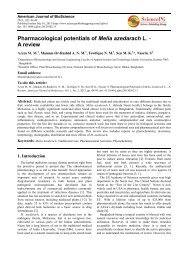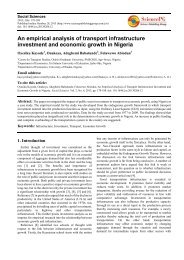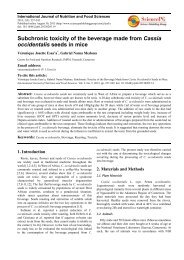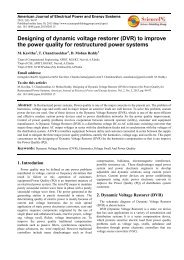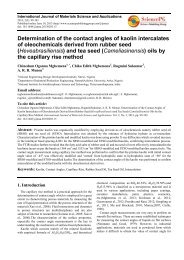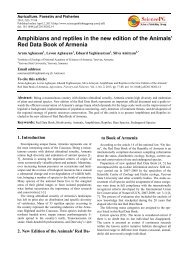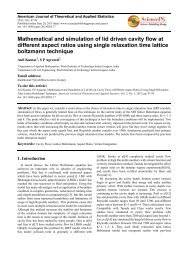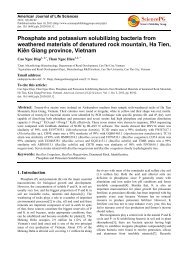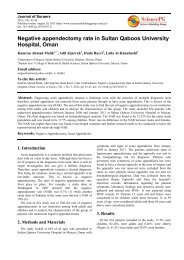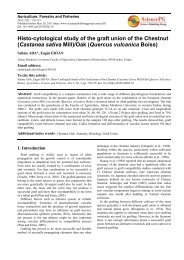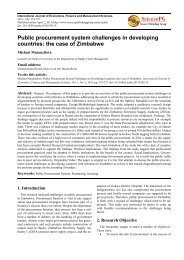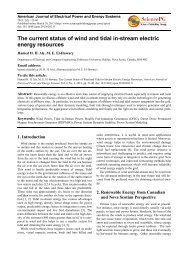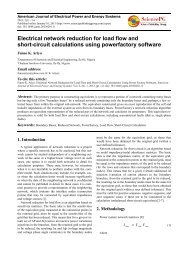Social Sciences 2013, 2(1): 14-21 17nistered by local authorities and supported by nati<strong>on</strong>al <strong>in</strong>stituti<strong>on</strong>s.As the MHP res<strong>on</strong>ated deeply with the prevail<strong>in</strong>gWorld Bank and UN-Habitat ideology <strong>of</strong> ‘enabl<strong>in</strong>g’ growthand markets, it is <strong>of</strong>ten referred to as a ‘best practice’ methodthat should be to be emulated by other countries [13]. At asem<strong>in</strong>ar organised by the Pr<strong>of</strong>essi<strong>on</strong>al Associati<strong>on</strong> <strong>of</strong> <strong>Sri</strong><strong>Lanka</strong> (OPSSL) which was held <strong>in</strong> Colombo <strong>in</strong> 1990,President <strong>of</strong> <strong>Sri</strong> <strong>Lanka</strong> Pramadasa stated about the MHP:The role <strong>of</strong> the state is as a supporter, guide and m<strong>on</strong>itor <strong>of</strong>poor communities. All decid<strong>in</strong>g and do<strong>in</strong>g is d<strong>on</strong>e by thepoor communities themselves. The poor family-the poorcommunities are at the very centre <strong>of</strong> their ownself-development process. The poor are the subjects. Andg<strong>over</strong>nment supports their <strong>in</strong>itiative and <strong>in</strong>tervenes <strong>on</strong>ly <strong>in</strong>matters and areas where they cannot solve problems <strong>on</strong> theirown [15]The MHP was made up <strong>of</strong> six sub-programs, <strong>in</strong>clud<strong>in</strong>gtwo that were implemented by the Nati<strong>on</strong>al Hous<strong>in</strong>g DevelopmentAuthority (NHDA): the Urban Hous<strong>in</strong>gSub-Program (UHSP) and the Rural Hous<strong>in</strong>g Sub-Program(RHSP). The rema<strong>in</strong><strong>in</strong>g four sub-programs were implementedby other <strong>in</strong>stituti<strong>on</strong>s: the Private Sector (Formal)Hous<strong>in</strong>g Sub-Program (PSFHSP); the Private Sector (Informal)Hous<strong>in</strong>g Sub-Program (PIHSP); the Plantati<strong>on</strong>Hous<strong>in</strong>g Sub-Program (PHSP); and the Mahaweli Hous<strong>in</strong>gSub-Program (MHSP) [15]. Fund<strong>in</strong>g for the MHP wasgenerated through the nati<strong>on</strong>al budget, foreign grants and the<strong>in</strong>come from the Hous<strong>in</strong>g Lottery.8. The 1.5 Milli<strong>on</strong> Houses Program(1990-1995)After the success <strong>of</strong> the One Milli<strong>on</strong> Houses program, theg<strong>over</strong>nment <strong>in</strong>troduced the 1.5 Milli<strong>on</strong> Houses Program <strong>in</strong>1990. However, there has been much criticism about theactual number <strong>of</strong> houses which were c<strong>on</strong>structed under theOne Milli<strong>on</strong> Houses Program [17]. Regardless <strong>of</strong> exactlyhow many houses were actually c<strong>on</strong>structed, a significantnumber <strong>of</strong> houses were built dur<strong>in</strong>g that program. The approach<strong>of</strong> the 1.5 Milli<strong>on</strong> Houses Program was slightlydifferent from the One Milli<strong>on</strong> Houses program as it addressed<strong>hous<strong>in</strong>g</strong> issues across all levels <strong>of</strong> society. Therewere eight sub-programs [15]: the Urban Hous<strong>in</strong>gSub-Program (UHSP); the Rural Hous<strong>in</strong>g Sub-Program(RHSP); the Disaster Hous<strong>in</strong>g Sub-Program (DHSP); the Prov<strong>in</strong>cialCouncil Hous<strong>in</strong>g Sub-Program (PCHSP); the MahaweliHous<strong>in</strong>g Sub-Program (MHSP) (MSP); the Plantati<strong>on</strong> Hous<strong>in</strong>gSub-Program (PHSP); the Employee Hous<strong>in</strong>g Sub-Program(EHSP); and the Individual Family Hous<strong>in</strong>g[15].Between 1978 and 1993, the UNP G<strong>over</strong>nment <strong>in</strong>vestedmany milli<strong>on</strong> rupees <strong>on</strong> <strong>hous<strong>in</strong>g</strong> programs <strong>in</strong> the country.The ma<strong>in</strong> fund<strong>in</strong>g mechanism for these programs wastreasury grants, foreign aid and Hous<strong>in</strong>g Lottery <strong>in</strong>come(Sevana Lottery) which was run by the M<strong>in</strong>istry <strong>of</strong> Hous<strong>in</strong>g.The Hous<strong>in</strong>g Lottery paid approximately 400 to 500 milli<strong>on</strong>rupees per annum to the Sevana Fund, which provided directassistance to low-<strong>in</strong>come households [6].9. Compact City Development(1994-2005)In 1994 the People’s Alliance (PA) G<strong>over</strong>nment w<strong>on</strong>power after 17 <strong>years</strong> <strong>of</strong> dom<strong>in</strong>ati<strong>on</strong> by the United Nati<strong>on</strong>alParty. Under the new g<strong>over</strong>nment, <strong>hous<strong>in</strong>g</strong> <strong>policies</strong> took anew directi<strong>on</strong> and <strong>in</strong>stituti<strong>on</strong>al reform and pr<strong>of</strong>essi<strong>on</strong>al<strong>in</strong>volvement significantly improved. The g<strong>over</strong>nment reformulated<strong>hous<strong>in</strong>g</strong> <strong>policies</strong> and created legal and <strong>in</strong>stituti<strong>on</strong>alc<strong>on</strong>diti<strong>on</strong>s more favourable for private and g<strong>over</strong>nmentsector <strong>in</strong>volvement <strong>in</strong> <strong>hous<strong>in</strong>g</strong> development. The major<strong>hous<strong>in</strong>g</strong> <strong>policies</strong> <strong>in</strong> this period were the provisi<strong>on</strong> <strong>of</strong> morehouses <strong>in</strong> <strong>urban</strong> areas and a qualitative improvement <strong>in</strong>rural/estate houses [6].The Presidential Task Force <strong>on</strong> Hous<strong>in</strong>g and Urban Developmentwas appo<strong>in</strong>ted <strong>in</strong> 1998 to draw up a macro-policyframework and an acti<strong>on</strong> program for both theshort and l<strong>on</strong>g-term physical development <strong>of</strong> <strong>Sri</strong> <strong>Lanka</strong>,with a view to improv<strong>in</strong>g the quality <strong>of</strong> life <strong>of</strong> its <strong>in</strong>habitantsand meet<strong>in</strong>g the aspirati<strong>on</strong> <strong>of</strong> a modern 21st Centurycity[17].The task force made an important recommendati<strong>on</strong> to theg<strong>over</strong>nment <strong>of</strong> <strong>Sri</strong> <strong>Lanka</strong> and the M<strong>in</strong>istry <strong>of</strong> Urban Development,C<strong>on</strong>structi<strong>on</strong> and Public Utilities that a newcompany named Real Estate Exchange (Pvt) Limited(REEL) should be established. This company is fullyowned by g<strong>over</strong>nment and its ma<strong>in</strong> shareholders are theUrban Development Authority (UDA), the Nati<strong>on</strong>al Hous<strong>in</strong>gDevelopment Authority (NHDA), the <strong>Sri</strong> <strong>Lanka</strong> LandReclamati<strong>on</strong> and Development Corporati<strong>on</strong> (SLLR&DC)and the Colombo Municipal Council (CMC). The motto <strong>of</strong>REEL is simple: “Homes for people and lands for development”.The operati<strong>on</strong>al arm <strong>of</strong> REEL is the Susta<strong>in</strong>ableTownship Programme (STP), which was also established <strong>in</strong>1998. It has been work<strong>in</strong>g <strong>in</strong> the city <strong>of</strong> Colombo by promot<strong>in</strong>ghigh-density <strong>hous<strong>in</strong>g</strong> with<strong>in</strong> a broad <strong>urban</strong> plann<strong>in</strong>gand development framework. This program aims tore-house those families who are encumbered with no titles<strong>on</strong> the valuable lands with<strong>in</strong> the city <strong>of</strong> Colombo <strong>in</strong> moderncompact townships, and liberate those lands for <strong>urban</strong> redevelopment[17].The ma<strong>in</strong> functi<strong>on</strong>s <strong>of</strong> REEL are to issue securitiesaga<strong>in</strong>st prime lands <strong>in</strong> Colombo and to create a sec<strong>on</strong>dary<strong>hous<strong>in</strong>g</strong> market and sec<strong>on</strong>dary mortgage <strong>in</strong>struments.REEL also promotes private public sector partnership <strong>in</strong>real estate and <strong>urban</strong> renewal and development. REEL <strong>of</strong>fersa low-cost, market-based soluti<strong>on</strong> for re-<strong>hous<strong>in</strong>g</strong> poorhouseholders <strong>in</strong> Colombo and <strong>of</strong>fers <strong>in</strong>centives to <strong>in</strong>vestorsto participate <strong>in</strong> mortgage and f<strong>in</strong>anc<strong>in</strong>g, <strong>hous<strong>in</strong>g</strong> and <strong>in</strong>frastructurec<strong>on</strong>diti<strong>on</strong>s and <strong>urban</strong> renewal and development. Itis expected to change the outdated laws perta<strong>in</strong><strong>in</strong>g to <strong>hous<strong>in</strong>g</strong>and real estate development when and where necessary.9.1. The REEL Process
18 Thushara Samaratunga et al.: <str<strong>on</strong>g>Reflecti<strong>on</strong>s</str<strong>on</strong>g> <strong>on</strong> <strong>over</strong> <strong>100</strong> <strong>years</strong> <strong>of</strong> <strong>urban</strong> <strong>hous<strong>in</strong>g</strong> <strong>policies</strong> <strong>in</strong> <strong>Sri</strong> <strong>Lanka</strong>A field survey c<strong>on</strong>ducted by Real Estate Exchange (Pvt)Limited (REEL) <strong>in</strong> 1999 revealed that there were 1,506poorly served settlements the city <strong>of</strong> Colombo, which c<strong>on</strong>ta<strong>in</strong>edapproximately 66,000 <strong>urban</strong> low-<strong>in</strong>come householders.These 66,000 householders occupied nearly 300 hectares<strong>of</strong> land area [17]. About 70 per cent <strong>of</strong> these under-utilisedland parcels existed <strong>in</strong> strategic locati<strong>on</strong>s whereland value is comparatively high. Most <strong>of</strong> the land wasstate-owned but state entities could not realise the value <strong>of</strong>their lands due to heavy encumbrances. The clearance <strong>of</strong>encumbrances and creati<strong>on</strong> <strong>of</strong> small-hold<strong>in</strong>gs can greatlyimpact <strong>urban</strong> development <strong>in</strong> Colombo and it was hopedthat liberat<strong>in</strong>g these lands would play a key role <strong>in</strong> chang<strong>in</strong>gColombo’s land use as planned out by the ColomboDevelopment Plan and the Colombo Metropolitan Regi<strong>on</strong>alStructure Plan CMRSP [2].REEL proposed to liberate 70 per cent <strong>of</strong> encumberedlands and dispose them <strong>in</strong> a public market for alternativeuses. The <strong>in</strong>come realised through this disposal would beallocated for the c<strong>on</strong>structi<strong>on</strong> <strong>of</strong> high-density <strong>hous<strong>in</strong>g</strong> <strong>in</strong> thebalance lands. Thus, the standard houses c<strong>on</strong>structedthrough the build<strong>in</strong>g <strong>in</strong>dustry for this program are givenfree to the affected household, respective <strong>of</strong> their previousownership status. It is a house-to-house exchange process.The benefits for this plan would work two ways: the beneficiaryfamily can enjoy a brand-new standard apartmentwhile the STP is able to provide prime lands for guided<strong>urban</strong> development.The Susta<strong>in</strong>able Township Program (STP) is add<strong>in</strong>gstandard houses to the nati<strong>on</strong>al <strong>hous<strong>in</strong>g</strong> stock without costto the state g<strong>over</strong>nment. The effect <strong>of</strong> employment generati<strong>on</strong>though the build<strong>in</strong>g <strong>in</strong>dustry is significant and its c<strong>on</strong>tributi<strong>on</strong>to the productivity <strong>of</strong> the city labor force is c<strong>on</strong>siderable.Thisprogram was a market-based, self-f<strong>in</strong>ancedproperty development strategy rather than that <strong>of</strong> astate-sp<strong>on</strong>sored, aid-led, c<strong>on</strong>venti<strong>on</strong>al strategy [18].10. The ‘Mah<strong>in</strong>da Ch<strong>in</strong>thana’ Program(2005-2010)The 2005 electi<strong>on</strong> was w<strong>on</strong> by the same rul<strong>in</strong>g partywhich had held power s<strong>in</strong>ce 1994, and a new president,Mah<strong>in</strong>da Rajapaksa, was elected. His electi<strong>on</strong> manifesto‘Mah<strong>in</strong>da Ch<strong>in</strong>thanaya’ categorically stated that "Everyfamily <strong>in</strong> <strong>Sri</strong> <strong>Lanka</strong> should own a house" (UPFA 2005). TheJana Sevana <strong>hous<strong>in</strong>g</strong> program was <strong>in</strong> l<strong>in</strong>e with the ‘Mah<strong>in</strong>daCh<strong>in</strong>thana’ visi<strong>on</strong>, under the supervisi<strong>on</strong> <strong>of</strong> PresidentMub<strong>in</strong>da Rajapaksa. Several sub-programs have been implementedunder this project, and under <strong>on</strong>e sub-program,1,000 selected families received a 500,000-rupee loan to c<strong>on</strong>structtheir houses and another 1,000 low-<strong>in</strong>come families weregranted <strong>hous<strong>in</strong>g</strong> loans up to a maximum <strong>100</strong>,000 rupees [20].Also, the “Diriya Piyasa” <strong>hous<strong>in</strong>g</strong> program, implemented bythe <strong>Sri</strong> <strong>Lanka</strong> Samurdhi Authority (SLSA) had c<strong>on</strong>structed5,000 houses <strong>in</strong> 2005, provid<strong>in</strong>g a last–ditch soluti<strong>on</strong> to theacute shelter problem <strong>of</strong> low-<strong>in</strong>come families [20].There were several g<strong>over</strong>nment <strong>in</strong>stituti<strong>on</strong>s engaged <strong>in</strong>facilitat<strong>in</strong>g the development <strong>of</strong> groups targeted for <strong>hous<strong>in</strong>g</strong>support. The Nati<strong>on</strong>al Hous<strong>in</strong>g Development Authority(NHDA) was the primary public sector <strong>in</strong>stituti<strong>on</strong> c<strong>on</strong>cernedwith implement<strong>in</strong>g <strong>hous<strong>in</strong>g</strong> programs. The NHDA had <strong>in</strong>troducedseveral <strong>hous<strong>in</strong>g</strong> programs especially for the targetedlow-<strong>in</strong>come households. Under the various <strong>hous<strong>in</strong>g</strong>development programs, the NHDA completed 46,021<strong>hous<strong>in</strong>g</strong> units the various <strong>hous<strong>in</strong>g</strong> development programs.The Real Estate Exchange (PVT) Ltd. (REEL), is alsoplann<strong>in</strong>g to improve, the liv<strong>in</strong>g standards <strong>of</strong> the approximately66,000 shanty dwellers <strong>in</strong> <strong>urban</strong> centres by provid<strong>in</strong>gthem with better <strong>hous<strong>in</strong>g</strong> and other <strong>in</strong>frastructure and facilities<strong>over</strong> the next 10 <strong>years</strong> [20]. The UDA has undertakenthe relocati<strong>on</strong> <strong>of</strong> dwellers <strong>in</strong> unauthorised slums and shanties<strong>in</strong> the project areas which have been identified as essentialfor city development.Under President Mah<strong>in</strong>da Rajapaksa's l<strong>on</strong>g-term <strong>hous<strong>in</strong>g</strong>development policy, as outl<strong>in</strong>ed <strong>in</strong> the 'Ten-Year Visi<strong>on</strong>' andthe 'Jana Sevana One Milli<strong>on</strong> Houses Program', theTen-Year Horiz<strong>on</strong> Development Framework was issued <strong>in</strong>November 2006. This is a broad policy framework c<strong>on</strong>sistentwith the ‘Mah<strong>in</strong>da Ch<strong>in</strong>thana’ Program, and it envisagesa plan to meet a large part <strong>of</strong> the grow<strong>in</strong>g demand for houses<strong>in</strong> <strong>Sri</strong> <strong>Lanka</strong>[21]. The policy aims to ensure the plannedhuman settlements take <strong>in</strong>to c<strong>on</strong>siderati<strong>on</strong> populati<strong>on</strong> density,land suitability and envir<strong>on</strong>mental susta<strong>in</strong>ability. The<strong>hous<strong>in</strong>g</strong> policy also c<strong>on</strong>sists <strong>of</strong> the adopti<strong>on</strong> <strong>of</strong> the verticaldevelopment approaches <strong>in</strong> high and medium density areas,implementati<strong>on</strong> <strong>of</strong> participatory approaches wherever possible,develop<strong>in</strong>g the <strong>hous<strong>in</strong>g</strong> f<strong>in</strong>ance market with primaryand sec<strong>on</strong>dary mortgage f<strong>in</strong>anc<strong>in</strong>g facilities and provid<strong>in</strong>gg<strong>over</strong>nment assistance for needy groups [21].The “Arunodaya” Urban Poor Hous<strong>in</strong>g Program was anotherlow-<strong>in</strong>come <strong>hous<strong>in</strong>g</strong> project implemented by the Rajapaksag<strong>over</strong>nment. It was run by the M<strong>in</strong>istry <strong>of</strong> UrbanDevelopment and Sacred Area Development. The M<strong>in</strong>istry<strong>of</strong> Urban Development was resp<strong>on</strong>sible for slum and shantyrelocati<strong>on</strong> with the aim <strong>of</strong> implement<strong>in</strong>g the present g<strong>over</strong>nment’spolicy ‘Mah<strong>in</strong>da Ch<strong>in</strong>thanaya’ with susta<strong>in</strong>able<strong>urban</strong> development. This program was funded without allocati<strong>on</strong>sfrom the C<strong>on</strong>solidated Fund <strong>of</strong> the G<strong>over</strong>nmentharnessed through the regulatory provisi<strong>on</strong>s made under theUDA law. Lack <strong>of</strong> funds is the ma<strong>in</strong> c<strong>on</strong>stra<strong>in</strong>t <strong>in</strong> this k<strong>in</strong>d <strong>of</strong>subsidised affordable <strong>hous<strong>in</strong>g</strong> program. However, this programcould create an avenue for revenue and then obta<strong>in</strong>sufficient funds without any difficulty. The ma<strong>in</strong> fund<strong>in</strong>gsource would be a service charge <strong>of</strong> 1% levied as the estimatedcost <strong>of</strong> c<strong>on</strong>structi<strong>on</strong> <strong>of</strong> build<strong>in</strong>gs exceed<strong>in</strong>g 5000square feet <strong>in</strong> floor area for the issue <strong>of</strong> Development Permit.However, the program was carried out solely based <strong>on</strong> <strong>in</strong>itiativesand drives <strong>of</strong> organised slum and shanty dwellersand local level leadership with the specific <strong>in</strong>itiatives, drivesand practices <strong>of</strong> shanty and slum dwellers to be accommodated<strong>in</strong> a clear framework methodology [12].The <strong>in</strong>volvement <strong>of</strong> slum and shanties communities <strong>in</strong> theplann<strong>in</strong>g and development <strong>of</strong> <strong>urban</strong> low-<strong>in</strong>come <strong>hous<strong>in</strong>g</strong>



